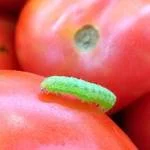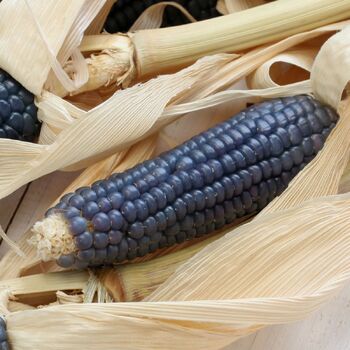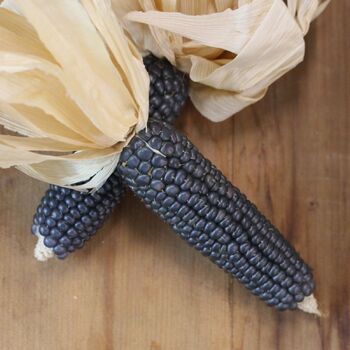
How to Grow Corn Seeds
Grow Guide #2255
Family: Poaceae
Binomial name: Zea mays
Life Cycle: annual
This 'How to Grow' guide details everything a home gardener needs to know to plant, grow and care for Corn (Zea mays).
Corn varieties can be classified as sweet corn or maize. Sweet corn is usually eaten fresh and has kernels that are yellow or white. Maize is usually dried and used for popping corn, to make maize flour or as a decoration. Maize kernels are often brightly coloured. Both varieties are grown in the same way, though there are differences in when and how they are harvested and stored.
When to Sow Corn Seeds
Corn is a warm season crop. Use the table below to identify the best time of year to sow corn seeds in your climate.
| JAN | FEB | MAR | APR | MAY | JUN | JUL | AUG | SEP | OCT | NOV | DEC | |
|---|---|---|---|---|---|---|---|---|---|---|---|---|
| Cool | ||||||||||||
| Temperate | ||||||||||||
| Sub-Tropical | ||||||||||||
| Tropical | ||||||||||||
| Arid |
Preparation
Corn plants are best grown in full sun. Choose a location that will receive at least 6 hours of full sun each day.
Corn plants need a well drained soil enriched with plenty of organic matter. Prepare soil by weeding it thoroughly, digging it over to loosen it and adding aged animal manure or compost. Keep the area free of weeds until planting. Learn more about preparing soil for planting here.
How to Sow Corn Seeds
Corn seeds do not require any treatment (eg soaking, stratification) before sowing.
Corn seeds grow best when they are sown directly into the garden.
- Sow seeds directly in the garden 15-25mm deep and 20-30cm apart, with rows 50-90cm apart.
- Keep soil moist but never wet or dry.
- Seeds should germinate in around 5-14 days at a soil temperature of 16-35°C.
- Young seedlings will need protection from pests, pets and weather until they are established.
Sow corn seed in blocks rather than long rows. Corn is wind pollinated and spacing plants in blocks helps to transfer pollen between plants to ensure good even pollination.
Corn is a tender crop that’s sensitive to frost. Do not transplant seedlings or sow seeds outside until all danger of frost has passed.
How to Grow Corn
Corn plants may need watering during the growing season. Water when the soil is dry about 5cm below the surface (test this by scratching away a little soil with your finger). Water deeply in the early morning or late afternoon. Avoid watering the leaves of plants to avoid fungal diseases. Learn more about watering here.
If soil was well prepared no extra fertiliser should be necessary. In poor soil or to give your plants an extra boost, application of a balanced fertiliser or one formulated for fruit and vegetables can be beneficial:
- Apply slow release fertiliser at the recommended rate when transplanting or when seedlings are 5-10cm tall.
- Apply liquid fertiliser at the recommended rate and frequency while plants are fruiting or flowering.
How to Harvest Corn
Sweet corn is ready to harvest when the silks at the end of the cobs turn brown and dry. Test for readiness by partially stripping the husk to expose some of the kernels. Pierce one of the kernels: if the juice is milky then the corn is ready to harvest.
Harvest cobs by holding them firmly and pulling them downwards while twisting to separate them from the stem. Eat sweet corn as soon as possible after harvest. Corn can be stored short term with or without its husk in the fridge. For longer term storage, corn can be blanched and then frozen.
Maize is ready to harvest when the silks and husks are dry and have turned brown.
Harvest cobs by holding them firmly and pulling them downwards while twisting to separate them from the stem. Remove the husks and hang or spread the cobs on a wire rack in a bright, well ventilated place for 2-3 weeks. The kernels should be dry not squishy. Store the cobs in a cool, dry place or remove the individual kernels and store them in an airtight container.
Common Problems when Growing Corn
Like all plants, corn is susceptible to some pests, diseases and other problems. Below is a list of the most common problems gardeners encounter when growing corn plants:
 Aphids are small (2-4mm long) sap-sucking insects that congregate on the new shoots or the undersides of leaves. They can cause leaves to wilt or become discoloured, and also excrete honeydew which can attract ants and other insect pests. To manage aphids, remove them by spraying with a garden hose, apply a soap or alcohol spray, or encourage predatory insects to your garden. Read more about aphids here.
Aphids are small (2-4mm long) sap-sucking insects that congregate on the new shoots or the undersides of leaves. They can cause leaves to wilt or become discoloured, and also excrete honeydew which can attract ants and other insect pests. To manage aphids, remove them by spraying with a garden hose, apply a soap or alcohol spray, or encourage predatory insects to your garden. Read more about aphids here..jpg) Empty or missing kernels on cobs is caused by poor pollination. Each kernel on a cob of corn is fertilised individually by pollen carried by wind from the tassels (male flowers) to the silks (female flowers) at the end of the cobs. Growing only a few plants, insects eating the silks and water stress can all impede pollination. Once silks emerge, catch pollen in a small bowl by gently shaking the tassels, then dip the silks into the bowl to transfer the pollen. Plant corn in blocks rather than rows, manage insect infestations and water regularly when silks emerge.
Empty or missing kernels on cobs is caused by poor pollination. Each kernel on a cob of corn is fertilised individually by pollen carried by wind from the tassels (male flowers) to the silks (female flowers) at the end of the cobs. Growing only a few plants, insects eating the silks and water stress can all impede pollination. Once silks emerge, catch pollen in a small bowl by gently shaking the tassels, then dip the silks into the bowl to transfer the pollen. Plant corn in blocks rather than rows, manage insect infestations and water regularly when silks emerge. Slugs and snails are molluscs that feed on tender leaves and shoots, mostly at night, leaving slimy trails behind them. Control them by removing their hiding places, keeping free range poultry, collecting them by torchlight or by placing traps. Read more about slugs and snails here.
Slugs and snails are molluscs that feed on tender leaves and shoots, mostly at night, leaving slimy trails behind them. Control them by removing their hiding places, keeping free range poultry, collecting them by torchlight or by placing traps. Read more about slugs and snails here. Armyworms, cutworms and other caterpillars can all eat the inside of fruit, making it inedible. Young caterpillars burrow into soft fruit, leaving just a small telltale hole on the fruit’s skin. Monitor fruit and remove any caterpillars you see. If necessary use insect exclusion netting or fruit bags to physically protect the fruit, or spray with Dipel.
Armyworms, cutworms and other caterpillars can all eat the inside of fruit, making it inedible. Young caterpillars burrow into soft fruit, leaving just a small telltale hole on the fruit’s skin. Monitor fruit and remove any caterpillars you see. If necessary use insect exclusion netting or fruit bags to physically protect the fruit, or spray with Dipel. Possums, birds and other animals can ruin a large percentage of your harvest overnight. Physically exclude pests by using netting or cages, or try spraying plants with a pungent homemade spray made from garlic, fish oil or mustard.
Possums, birds and other animals can ruin a large percentage of your harvest overnight. Physically exclude pests by using netting or cages, or try spraying plants with a pungent homemade spray made from garlic, fish oil or mustard.


.png)






